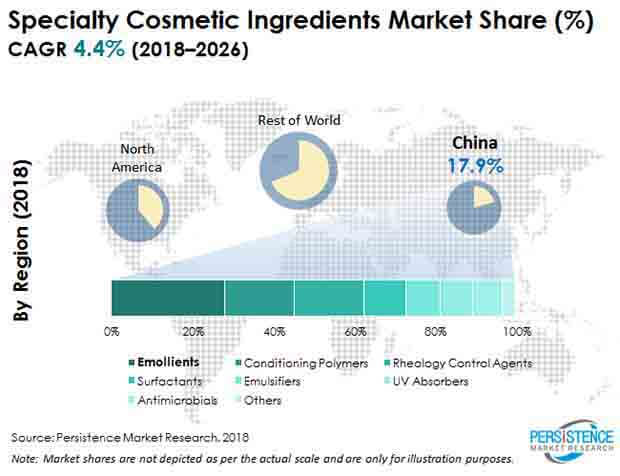Specialty Cosmetic Ingredients Market Segmented By Emollients, Anionics Surfactants, Non-Anionics Surfactants, Cationics Surfactants, Amphoterics Surfactants, Conditioning polymers, Rheology control agents, UV absorbers, Emulsifiers, Antimicrobials Product Type
Industry: Chemicals and Materials
Published Date: February-2019
Format: PPT*, PDF, EXCEL
Delivery Timelines: Contact Sales
Number of Pages: 240
Report ID: PMRREP27232
Specialty cosmetic ingredients are the specialty ingredients that are added to body products and cosmetics to impart specific properties to the end product. The global specialty cosmetic ingredients market report provides an overview of the market dynamics including drivers, restraints, opportunities, trends, value (US$ Mn) and volume (Tons) projections, along with detailed information regarding recent developments for the period between 2017 and 2026.
The global specialty cosmetic ingredients market has been segmented on the basis of product type into emollients, surfactants, conditioning polymers, rheology control agents, UV absorbers, emulsifiers and antimicrobials. These specialty cosmetic ingredients add various unique properties such as foaming and water resistance to the end cosmetic product. Hence, specialty cosmetic ingredients find a diverse set of applications such as hair care, skincare, oral care, fragrance and make-up cosmetics.
The global market was pegged at US$ 9595.3 Mn in 2017 & is expected to expand at a CAGR of 4.4% during the forecast period. Increasing consumption of cosmetics and personal care products with rising advancements and innovations in end products are some of the factors driving the growth of the specialty cosmetic ingredients market.
Conditioning polymers are extensively used as specialty cosmetic ingredients in cosmetic products such as shampoo, body wash, liquid hand wash, and a variety of hair and skincare products. Most importantly, conditioning polymers are used in sweat-proof cosmetics, which register high demand in warm and temperate regions of the globe.
Attributing to this, the conditioning polymers segment of the global specialty cosmetic ingredients market is reported to hold a significant share of 22.3% in 2018. By type, the emollients segment has been gaining traction with the large-scale adoption of emollients in a wide range of skincare products, owing to their lubrication and moisturizing properties.
This segment is anticipated to witness a growth rate of 4.9% during the forecast period, aided by the rapid growth in the demand for moisturizers worldwide.
Surfactants are lipids that are widely used as specialty cosmetic ingredients. The key factor that drives their application as specialty cosmetic ingredients is that they are compatible with both oil and water. Hence, they are used in cosmetics for foaming, cleansing, thickening and other special effects.
As a result, they form a major class of specialty cosmetic ingredients. They can be further sub segmented into anionic, non-anionic, cationic, and amphoteric, among others based on the charge carried by the surfactant molecule. Of these sub-segments, the anionic sub-segment is pegged to remain prominent, valued at US$ 659.3 Mn in 2018.
It is expected to account for a substantial share of 36.9% by the end of 2026. This upsurge in the segment’s share can be attributed to the growing demand for cleansing products, in which anionic surfactants are one of the key specialty cosmetic ingredients.
Skincare and hair care are the prominent application segments in the global specialty cosmetic ingredients market. Recent trends of urbanization and development in industries such as film and fashion have resulted in an upsurge in specialty cosmetic ingredients sales in the makeup application segment.
This market trend is specific to certain regions such as North America, where the makeup segment is expected to register 1.1% growth by the end of 2026.

North America and Europe are pegged to be prominent regions in the global specialty cosmetic ingredients market with the presence of noteworthy market players. Rapidly growing economies of countries such as India and China in the SEAP (South East Asia and Pacific) region offer ample opportunities of growth in the global specialty cosmetic ingredients market.
China has been emerging as a significant region in the global market since the country is open to public, private and foreign investments. Manufacturers of specialty cosmetic ingredients are expanding and specifically investing in this region as it offers high growth opportunities in the global specialty cosmetic ingredients market.
The global specialty cosmetic ingredients market is fairly consolidated, with prominent manufacturers holding substantial market shares as of 2017.
Some of the prominent players covered in this market study include BASF SE, Croda International Plc., Evonik Industries AG, Akzo Nobel N.V., Solvay SA The Dow Chemical Company, Lonza Group, Eastman Chemical Company, Clariant AG, Ashland Global Specialty Chemicals Inc., and Innospec Inc., among others.
In the recent past, the global specialty cosmetic ingredients market has witnessed compelling advancements in the specialty cosmetic ingredients product portfolios of key players; some of which are mentioned below.
| Attribute | Details |
|---|---|
| Product Type |
|
| Application |
|
| Region |
|
To know more about delivery timeline for this report Contact Sales
